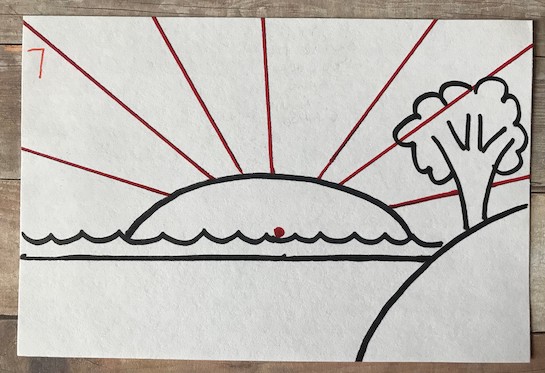Students will observe Romero Britto’s art then create a drawing using simple patterns. Recommended for 1st Graders.
Color: the visible range of reflected light.
Line: the flat path of a dot through space used by artists to control the viewer’s eye movement; a long narrow mark or stroke made on or in a surface; a thin mark made by a pencil, pen, or brush.
Shape: a two-dimensional (flat) area enclosed by a line.
Pattern: the repetition of the elements of visual arts in an organized way.
Repetition: the repeated use of particular elements pattern, movement, rhythm, or unity.
Layering: placing something “in front” of something else to create a sense of depth.
Pop Art: A genre (style) of art in 1950s and 1960s Britain and America. It is characterized by an imaginative interpretation of popular culture. Britto chose a child-like comic-strip style of drawing using thick outlines and bright colors.
Romero Britto is an internationally known pop artist, known as much for his use of vibrant, bold, color as for his optimistic view of the world around him. Romero Britto was born in Brazil in 1963. He is a self-taught artist who began by painting what he saw and imagined on any surface he could find, even scraps of paper or cardboard.
He is a painter and sculptor who combines cubism, pop art, and graffiti in his artwork. His art features bright, vibrant colors, bold patterns, and strong lines. Britto’s art conveys hope, happiness, and a sense of peace and unity. In 1983 Britto traveled to Paris where he was influenced and inspired by the art of Matisse and Picasso. Britto has resided in Miami since 1989 and spends much of his time creating art that benefits over 250 charities, many of which specifically help children.
Throughout his success, Britto never stopped believing that art is too important not to share. He continues to this day to create art that exudes love, happiness and hope. Romero believes the artist can be an agent of positive change, and his work is proof of the impact an artist can make.
What do you notice about the type of shapes/patterns that Romero Britto uses? They are simple, easy to draw and repeat.
What type of color is used? Bright. What do these colors convey? Happiness.Students will: observe Romero Britto’s art; create a drawing using simple patterns; follow directions using a step by step lesson.
This lesson is a guided drawing. Students will use permanent markers and do their best to imitate the teacher’s steps. If a student makes a mistake show them how to turn any stray lines into part of the background pattern. Encourage the students to keep going with each step even if they get stressed.






Lesson written by Laurelle Graves. Artist info from RomeroBritto and ArtNet websites. Pop Art Movement from The Art Story.
21st Century Thinking Skills
Observing, making connections, visualizing, sequencing, determining main idea, finding evidence, decision making, evaluating.
WA State Learning Standards
(VA:Cr1.2.1) a. Use observation and investigation in preparation for making a work of art.
(VA:Cr2.1.1) a. Explore uses of materials and tools to create works of art or design.
(VA:Cr2.2.1) a. Demonstrate safe and proper procedures for using materials, tools, and equipment while making art.
(VA:Cr3.1.1) a. Use art vocabulary to describe choices while creating art.
(VA:Pr4.1.1) a. Explain why some objects, artifacts, and artwork are valued over others. This happens when you explain about styles or art and why his art is special.
(VA:Re9.1.1) a. Classify artwork based on different reasons for preferences.
(VA:Cn11.1.1) a. Understand that people from different places and times have made art for a variety of reasons.
Please note: These lesson plans are intended for non-profit use only. Use of these plans for commercial purposes should give attribution to the Issaquah Schools Foundation and be accompanied by a nominal donation at www.isfdn.org/donate. Thank you.
Fueling Success for Every Student, Every School